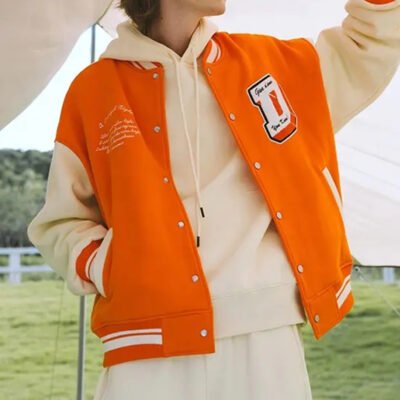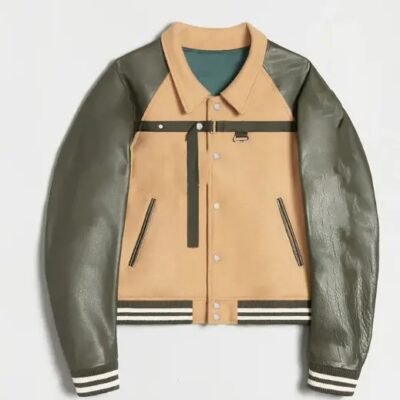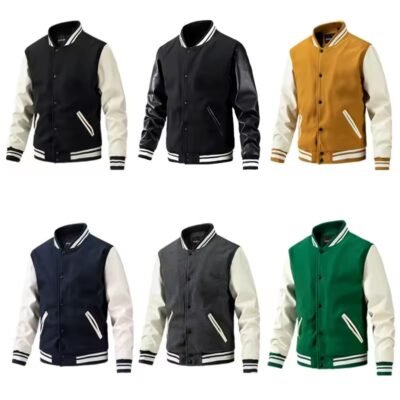Introduction
Varsity jackets, often associated with school pride and sports achievements, have become a staple in fashion. With their classic wool and leather design, they symbolize not only athletic success but also style and individuality. Whether you are planning to create your own line of varsity jackets or simply want to know more about the manufacturing process, this article will walk you through the key steps involved in producing these iconic jackets.
Keywords: varsity jacket, varsity jacket production, custom varsity jacket, jacket manufacturing process, design a varsity jacket
Step 1: The Design Phase
The first and most important step in creating a varsity jacket is the design. A varsity jacket typically consists of a wool body and leather sleeves, but modern variations may incorporate different materials and customizations. During the design phase, several key factors need to be considered:
Choosing Materials
The material selection is critical for both the jacket’s look and its durability. The wool used for the body is generally made from high-quality fibers to ensure warmth and comfort. Leather, often used for the sleeves, adds a timeless look and durability. Additionally, manufacturers may choose other fabrics such as faux leather, satin, or nylon depending on the specific design and target market.
Customization Options
Varsity jackets are known for their personalized elements, such as embroidered letters, team logos, and patches. During the design phase, it’s essential to decide what type of customization will be added to the jacket, whether it’s a school name, sports team logo, or individual initials.
Color Scheme and Style
Varsity jackets often follow specific color patterns, typically matching school colors or sports team uniforms. Designers select complementary colors for the wool body, leather sleeves, and ribbed cuffs and collar. The style of the jacket, whether it will be fitted or oversized, is also decided in this stage.
Step 2: Pattern Making
Once the design is approved, the next step is creating the pattern. The pattern is a template for all the components of the varsity jacket, including the front and back panels, sleeves, collar, and cuffs. Pattern makers carefully measure and cut the fabric to ensure that all pieces will fit together perfectly.
Cutting the Fabric
Using the patterns, fabric is carefully cut into the necessary shapes. This includes the wool body panels, leather sleeves, and ribbed knit cuffs. Precision is crucial during this stage, as slight discrepancies in the cut can result in an ill-fitting jacket.
Step 3: Assembly
Now that all the pieces are cut and prepared, the next step is to assemble the varsity jacket. This involves stitching together the wool body, leather sleeves, and ribbed knit collar and cuffs.
Sewing the Panels Together
The body of the jacket is typically sewn together first, starting with the side seams. Once the body is complete, the leather sleeves are attached. Special sewing machines are used to handle the thicker material of the leather, ensuring a secure and clean finish. The sleeves are then attached to the body, and the shoulder seams are reinforced to maintain durability.
Attaching the Collar and Cuffs
The final pieces to be sewn on are the ribbed collar and cuffs. These are typically made from a stretchy knit fabric and provide the jacket with a snug fit. The cuffs and collar are carefully sewn onto the wool and leather components to ensure they are securely attached and aligned with the overall design.
Step 4: Customization and Embellishments
One of the defining features of varsity jackets is their level of customization. After the basic structure of the jacket is assembled, it’s time to add personalized elements.
Embroidery and Patches
Embroidery is one of the most popular forms of customization for varsity jackets. This can include letters, numbers, or logos stitched onto the wool body or leather sleeves. Depending on the complexity of the design, different types of embroidery machines may be used, ranging from basic single-needle machines to more advanced multi-needle machines that can handle intricate designs.
Additionally, patches such as school emblems, sports team logos, or other decorative elements can be sewn onto the jacket. These patches are typically made from high-quality fabrics like felt or twill and are carefully attached to ensure they don’t peel or wear out.
Buttons and Zippers
Many varsity jackets feature a snap button or zipper closure. The choice of closure will depend on the jacket’s design and the brand’s preference. Buttons are typically made of durable plastic or metal and are sewn onto the jacket. Zippers, if used, are securely attached to ensure they function properly.
Step 5: Quality Control and Final Touches
Once the customization process is complete, each varsity jacket undergoes a rigorous quality control check. This ensures that there are no defects in stitching, embroidery, or overall construction.
Checking for Flaws
Each jacket is carefully inspected for any issues, such as uneven stitching, misaligned patches, or fabric imperfections. Any jackets that do not meet the brand’s quality standards are sent back for adjustments or repairs.
Ironing and Packaging
To ensure the jackets look their best, they are ironed and steamed to remove any wrinkles. After that, they are neatly packaged for delivery. The jackets are carefully folded and placed in protective plastic or garment bags to keep them in pristine condition until they reach the customer.
Step 6: Distribution
The final step in the process is the distribution of the varsity jackets. Once the jackets have been made, packaged, and quality-checked, they are sent out to stores or shipped directly to customers who have ordered them online. The jackets are often sold as part of a school or team uniform collection, but they are also popular as casual fashion wear.
Conclusion
Creating a varsity jacket involves a meticulous process that blends craftsmanship with customization. From selecting the right materials and designing the jacket to stitching, embellishing, and packaging, each step ensures that the final product meets high-quality standards. Whether you’re looking to purchase a custom varsity jacket for your school, sports team, or as a stylish fashion piece, understanding the production process helps you appreciate the effort that goes into making these iconic jackets.
If you’re considering creating a varsity jacket, remember that each step from design to delivery plays an important role in bringing your vision to life. By working with a trusted manufacturer and selecting high-quality materials, you can ensure that your varsity jacket is both stylish and durable.
Keywords: varsity jacket, varsity jacket production, design varsity jacket, custom jacket, jacket manufacturing process, jacket customization






